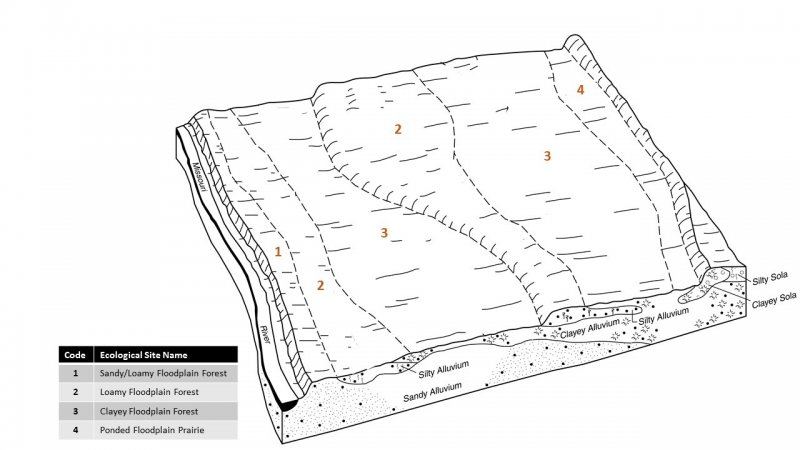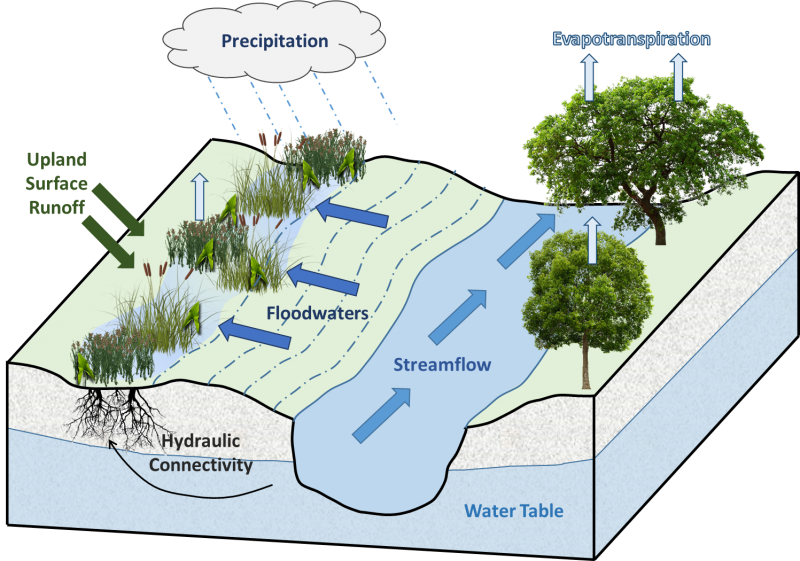
Natural Resources
Conservation Service
Ecological site R107XB018MO
Ponded Floodplain Marsh
Last updated: 5/21/2020
Accessed: 12/21/2025
General information
Provisional. A provisional ecological site description has undergone quality control and quality assurance review. It contains a working state and transition model and enough information to identify the ecological site.
Figure 1. Mapped extent
Areas shown in blue indicate the maximum mapped extent of this ecological site. Other ecological sites likely occur within the highlighted areas. It is also possible for this ecological site to occur outside of highlighted areas if detailed soil survey has not been completed or recently updated.
MLRA notes
Major Land Resource Area (MLRA): 107X–Iowa and Missouri Deep Loess Hills
The Iowa and Missouri Deep Loess Hills (MLRA 107B) includes the Missouri Alluvial Plain, Loess Hills, Southern Iowa Drift Plain, and Central Dissected Till Plains landform regions (Prior 1991; Nigh and Schroeder 2002). It spans four states (Iowa, 53 percent; Missouri, 32 percent; Nebraska, 12 percent; and Kansas 3 percent), encompassing over 14,000 square miles (Figure 1). The elevation ranges from approximately 1565 feet above sea level (ASL) on the highest ridges to about 600 feet ASL along the Missouri River near Glasgow in central Missouri. Local relief varies from 10 to 20 feet in the major river floodplains, to 50 to 100 feet in the dissected uplands, and loess bluffs of 200 to 300 feet along the Missouri River. Loess deposits cover most of the area, with deposits reaching a thickness of 65 to 200 feet in the Loess Hills and grading to about 20 feet in the eastern extent of the region. Pre-Illinoian till, deposited more than 500,000 years ago, lies beneath the loess and has experienced extensive erosion and dissection. Pennsylvanian and Cretaceous bedrock, comprised of shale, mudstones, and sandstones, lie beneath the glacial material (USDA-NRCS 2006).
The vegetation in the MLRA has undergone drastic changes over time. Spruce forests dominated the landscape 30,000 to 21,500 years ago. As the last glacial maximum peaked 21,500 to 16,000 years ago, they were replaced with open tundras and parklands. The end of the Pleistocene Epoch saw a warming climate that initially prompted the return of spruce forests, but as the warming continued, spruce trees were replaced by deciduous trees (Baker et al. 1990). Not until approximately 9,000 years ago did the vegetation transition to prairies as climatic conditions continued to warm and subsequently dry. Between 4,000 and 3,000 years ago, oak savannas began intermingling within the prairie landscape, while the more wooded and forested areas maintained a foothold in sheltered areas. This prairie-forest transition ecosystem formed the dominant landscapes until the arrival of European settlers (Baker et al. 1992).
Classification relationships
Major Land Resource Area (MLRA): Iowa and Missouri Deep Loess Hills (107B) (USDA-NRCS 2006)
USFS Subregions: Central Dissected Till Plains Section (251C); Missouri River Alluvial Plain (251Cg) (Cleland et al. 2007)
U.S. EPA Level IV Ecoregion: Missouri Alluvial Plain (47d) (USEPA 2013)
Biophysical Setting (LANDFIRE 2009): Eastern Great Plains Wet Meadow-Prairie-Marsh (4214880)
Ecological Systems (National Vegetation Classification System, Nature Serve 2015): Eastern Great Plains Wet Meadow, Prairie and Marsh (CES205.687)
Eilers and Roosa (1994): Wet Depressions
Iowa Department of Natural Resources (INAI nd): River Bulrush Marsh
Missouri Natural Heritage Program (Nelson 2010): Marsh
Nebraska Game and Parks Commission (Steinauer and Rolfsmeier 2010): Eastern Bulrush Deep Marsh
Plant Associations (National Vegetation Classification System, Nature Serve 2015): Schoenoplectus fluviatilis - Schoenoplectus spp. Marsh (CEGL002221)
Ecological site concept
Ponded Floodplain Marshes are located within the green areas on the map (Figure 1). They occur on floodplains in depressions, oxbows, and sloughs of riverine systems. Soils are Entisols and Mollisols that are very poorly to poorly drained and very deep, formed from alluvium and loess. The site experiences seasonal flooding and subsequent ponding for a significant portion of the growing season, resulting in a plant community dominated by hydrophytic herbaceous vegetation.
The historic pre-European settlement vegetation on this site was dominated by emergent herbaceous vegetation adapted to flooded or saturated conditions. River bulrush (Bolboschoenus fluviatilis (Torr.) Soják) and broadleaf arrowhead (Sagittaria latifolia Willd.) are the dominant and diagnostic species for the site. Hardstem bulrush (Schoenoplectus acutus (Muhl. ex Bigelow) Á. Löve & D. Löve var. acutus), broadfruit bur-reed (Sparganium eurycarpum Engelm.), and water knotweed (Polygonum amphibium L.) are other common emergent associates. Herbaceous species typical of an undisturbed plant community associated with this ecological site include tufted loosestrife (Lysimachia thyrsiflora L.) and small beggarticks (Bidens discoidea (Torr. & A. Gray) Britton) (Drobney et al. 2001; Steinauer et al. 2003; Steinauer and Rolfsmeier 2010; Nelson 2010; Ladd and Thomas 2015). Historically, seasonal flooding and fire were the primary disturbance factors, while animal predation was a secondary factor (LANDFIRE 2009; Nelson 2010).
Relative to other floodplain prairie ecological sites in the MLRA, Ponded Floodplain Marshess occur lower on the landscape, closer to the waterways. Ponded Floodplain Marshes are also affected by both flooding and ponding, while other floodplain sites are only affected by flooding.
Associated sites
| F107XB016MO |
Loamy Floodplain Forest Silty alluvium soils on floodplains near stream channel including Blake, Danbury, Floris, Gilliam, Grable, Grable variant, Haynie, Haynie variant, Kenridge, Landes, Lossing, McPaul, Modale, Modale variant, Moniteau, Morconick, Motark, Moville, Nodaway, Omadi, Paxico, Ray, Rodney, Scroll, Ticonic, Udifluvents, Udorthents, and Waubonsie |
|---|---|
| F107XB017MO |
Clayey Floodplain Forest Clayey alluvium soils on floodplains near stream channel including Albaton, Blencoe, Blend, Leta, Myrick, Onawa, Onawet, Owego, Parkville, Percival, and SansDessein |
| F107XB015MO |
Sandy/Loamy Floodplain Forest Sandy alluvium soils on floodplains adjacent to channel including Alluvial land, Buckney, Carr, Grable, Haynie, Hodge, Kenmoor, Psammaquents, Riverwash, Sarpy, Treloar, and Waubonsie |
Similar sites
| R107XB023IA |
Natric Floodplain Prairie Natric Floodplain Prairies have a significant component of salt/gypsum in the soils and do not pond |
|---|---|
| R107XB019MO |
Wet Floodplain Prairie Loamy Floodplain Prairies have moderately well-drained soils and do not pond |
| R107XB025IA |
Loamy Floodplain Prairie Wet Floodplain Prairies have somewhat poorly to poorly-drained soils and do not pond |
Table 1. Dominant plant species
| Tree |
Not specified |
|---|---|
| Shrub |
Not specified |
| Herbaceous |
(1) Bolboschoenus fluviatilis |
Click on box and path labels to scroll to the respective text.


